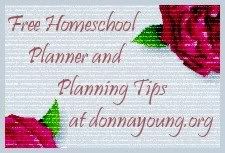Well, it seems we’re all homeschoolers now! Whether you’ve been homeschooling for a couple of weeks, or many years like me (since 1993!) there are simple things you can do at home to keep your kids learning, even if you don’t have a “curriculum” to help you.
Let’s start with some basics.
Start with a simple daily routine. Let’s face it, everyone feels better when their mealtimes and sleep times are regular. For children-especially young children-this is vitally important, and will even affect their moods and behavior. (Take a look at the tab above on “Routine” for more. ) Here is an example of a good daily routine:
- Start with Bible: Worship together (sing hymns, Sunday School Songs or worship songs from your church. If you feel that you can’t sing well enough to do this, sing along with a CD or YouTube. Next, work on Bible memorization: Considering everything that’s going on in the world right now, why not memorize some verses that help us not to be afraid or that remind us of the attributes of God? For example: John 14:27; Philippians 6:6-7; John 14:27 (the Amplified version of this is awesome); 1 Peter 5:7; Isaiah 12:2, 41:10, 43:1; Psalms 62:8, 107:20; 1 Timothy 1:7; Matthew 6:34. For older kids, consider memorizing Psalms 23 or Psalms 91 (and praying them too!) Finally, read from a children’s Bible storybook or from the Bible itself.
- Next, depending on the age(s) of your children, either take a short break or move on to your first subject-usually math. You don’t need a math book to do this! The first thing you need to do is see if your children have their basic math facts memorized. If they don’t, go from there. It’s easy and fun to work on math facts by playing games. For example, if you have a pair of dice at home or a deck of cards, you can play all kinds of fun games that teach the facts:
- Preschoolers can play Trash, matching games, War, The Smiley Face game, and more (Smiley Face Game: Cut index cards into half sizes-you’ll need at least 40 half-sized cards, depending on what you want to teach via this game. If teaching the alphabet, for example: Make a card for each letter and then make four to six “happy face cards” (draw a smiley face on them), and four “frowny faces” as well (draw a frowning face.) To play: Take turns drawing cards. Players who can name the letter or the sound of the letter get to keep their card. If they can’t, they must put their card at the bottom of the pile to be drawn again. If a player draws a happy face, they get to keep the card automatically. If they draw a frowning face, they set the card to the side (no one gets to keep it.) The player with the most cards after all cards are drawn is the winner. NOTE: You can also use your alphabet cards to have your kids lay them out from A-Z; practice spelling, etc. You can teach anything with this game: Numbers, addition, shapes, colors, and more, depending on what you put on your cards…just tell your child the answers at first if the concepts are new to them.
- Dice Games: Set up a sheet of paper with the names of your children (and you) in columns. Set a goal number depending on the age of your children: 10, 25, 50 or 100. Have children roll two dice and write down the number they roll. Take turns doing this, adding the sum of each roll to their tally. The first player to get to the number or decided on at the beginning of the game wins. You can also write down the numbers 1-12, then roll two dice, marking off the numbers you roll as you go (you can split the dice between two numbers.) Try to be the first to mark off all your numbers (this is a version of “Shut the Box”.)
- Play traditional card games that include counting or math: In Golf and Rummy, you have to add up your scores. In Casino, you add cards together to “build” a number that you can later pick up. These are games our family likes to play just for fun! Also consider Dice Games or Tenzi Games if you have lots of dice (my after school kids play with five dice, and practice their addition/subtraction: Ask them to roll their dice to add up to a certain number, or ask them to roll all fives (“Five fives! What does that add up to?”) OR even play Yahtzee.
- Other things you can do for math besides the usual drills (which you can find online for free, or simply write out your own): Print up a 100’s Chart and learn to count and skip count! Start with tens, then fives, then two’s); help younger students grasp the concepts in math by using counters (buttons, beans, etc).
- Next, take time for a recess: At least 30 minutes for kids to play, preferably outside. If they are playing inside, keep them off the electronics!
- Next subject: Language Arts: This encompasses a variety of subjects, including reading, grammar, writing, spelling, and vocabulary. You can teach them all together by pulling out short sections of books (the literature approach.) Depending on your child’s abilities and interests, choose a passage that is a paragraph or two long, and includes a few words h/she may not recognize or know how to spell. Suggestions: Classic books you have at home, non-fiction books s/he is interested in, or even a passage from the Bible. You can use the passage to help your child practice reading aloud smoothly and with expression-this is an important skill that everyone should have-but you can also turn the passage into a complete English lesson:
- Day one: Have your child read the selection to you. Have him/her write down any words s/he doesn’t know how to read, words you don’t think s/he can spell, and words s/he can’t define. (Define them simply for him/her at this time.) Write the words that your child can’t read or struggles to read onto a list or a set of flashcards for later practice. Have your child explain to you why the errors are errors (“Why do we need a question mark here? Why is the comma important?” and so on. Refer to a grammar guide if necessary if you don’t know the answers–you might have to order one from Amazon.) This helps your child practice reading, writing (editing), punctuation, spelling.
- Day Four: Have your child copy the passage down one more time, using their best handwriting, and then have him/her check it for mistakes. Use your word lists/flashcards to review spelling and vocabulary. This teaches reading, handwriting, grammar, spelling, and vocabulary.
- Day Five: Dictate the passage to your child, a little at a time, and have them write it down. Check the finished passage for punctuation, grammar, and spelling errors. Have your child correct any mistakes, and write down the words misspelled to review the following week. This teaches reading, listening, handwriting, grammar, and spelling.
- Other things you could try for Language Arts: Memorizing the parts of speech, rules of punctuation, etc; listening to passages and then telling them back; establishing daily reading times; playing Mad Libs; Spelling games like Scrabble, Scrabble Slam, Boggle, or Bananagrams.
- Take another break!
- Science and history: Read aloud to your child or watch a history/science video.
You should also offer/plan arts and crafts activities at least two or three times a week. If you don’t have the supplies you need, you can order on Michaels online or use their new curbside pickup.
This makes a complete homeschool day. It shouldn’t take any longer than two to four hours, max. Homeschooling is efficient–a lot of time is saved compared to public school. There is no waiting for the rest of the class when you are done, no passing out papers, and no waiting on the teacher to deal with a difficult child. For younger children (Kindergarten-second or third grade), plan to spend between 15-30 minutes per subject, on average; for children fourth grade and up, plan for no more than 40-45 minutes per subject.
While you are home, don’t forget life skills: Take the time to teach your child how to work, if you haven’t already, and how to do things like cook, load/unload the dishwasher, do laundry, pull weeds, and so on (depending on age.)
Most of all, make Bible your most important subject. Reassure your child that everything is going to be OK, and be sure to have some fun! Plan for it intentionally. You are blessed to have the internet to use to help you; be sure to make good use of it, especially Pinterest.
Blessings,
Susan





